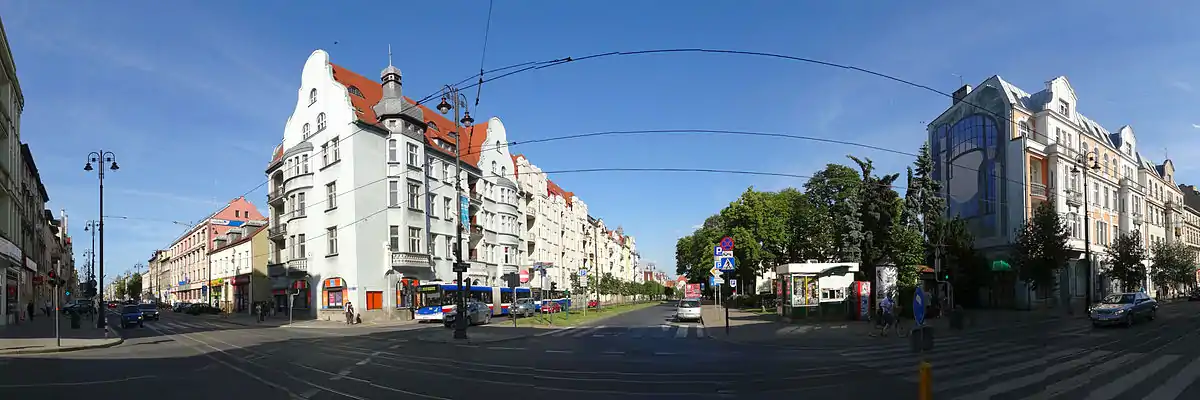| Rudolf Kern Tenement | |
|---|---|
Polish: Kamienica Rudolfa Kerna w Bydgoszczy | |
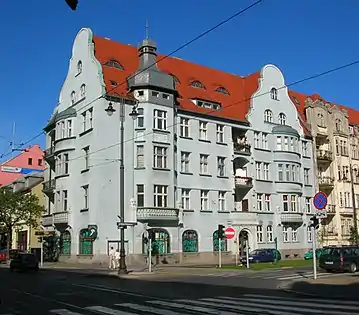 Tenement from Gdańska Street | |
| General information | |
| Type | Tenement |
| Architectural style | Art Nouveau |
| Classification | Nr.601377-Reg.A/1086, 20 November 1995[1] |
| Location | 1 Mickiewicz Alley, at the intersection with Gdańska Street, Bydgoszcz, |
| Coordinates | 53°7′55″N 18°0′36″E / 53.13194°N 18.01000°E |
| Groundbreaking | 1903 |
| Completed | 1904 |
| Client | Rudolf Kern |
| Technical details | |
| Floor count | 5 |
| Design and construction | |
| Architect(s) | Rudolf Kern |
Rudolf Kern Tenement is a habitation building located at 1 Mickiewicz Alley, in Bydgoszcz, Poland. It has been inscribed on the Kuyavian-Pomeranian Voivodeship Heritage List.
Location
The building stands on the eastern side of Gdańska Street at the intersection with Mickiewicz Alley.
It stands close to remarkable tenements in the same street:
- Alfred Schleusener Tenement at 62;
- Józef Święcicki tenement at 63;
- Eduard Schulz Tenement at 66/68;
- Tenement at 71 Gdańska street;
- Tenement at 75 Gdańska street;
- Ernst Bartsch tenement at 79;
- Paul Storz Tenement at 81.
History
On the plot, before the current building, there was a tavern (German: wirtschaft), managed by Emil Manthei[2]
This made the area prone to leisure, emphasized by the presence, since the end of the 19th century, of a theatre and a restaurant on the other side of the intersection (at 66-68 Gdańska street).
The house was built in 1903–1904, designed by the architect Rudolf Kern, a student of Józef Święcicki who also erected or redesigned other buildings in Gdańska Street:[3]
- August Mentzel Tenement at 5;
- Eduard Schulz Tenement at 66/68;
- Tenement at 71 Gdańska street.
Rudolf Kern originally erected the tenement for his own use, private and business. He lived there until 1922.
The building will soon accommodate a four-star hotel, including a gastronomic restaurant, with recreational and commercial areas.[4]
Features
The building has a decorative Art Nouveau facade. It has four main floors and one hidden in the upper roof. In a way its size balances the symmetry with the opposite building.[5]
It is characterized by an asymmetric arrangement of loggia and bays, typical decorative elements including leaf and tendril motifs, intertwined organic forms, mostly curvaceous in shape.[5]
Notable elements:
- low-relief adorned portal;
- large threatening masks on the facade;
- many interior design original elements such as staircase, stained glass, woodwork.
The building has been put on the Kuyavian-Pomeranian Heritage List Nr.601377 Reg.A/1086, on 20 November 1995.[1]
Gallery
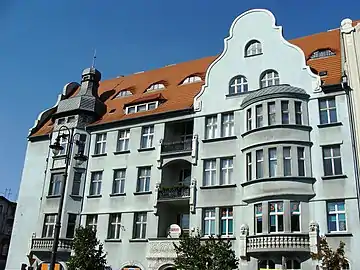 Frontage onto Mickiewicz alley
Frontage onto Mickiewicz alley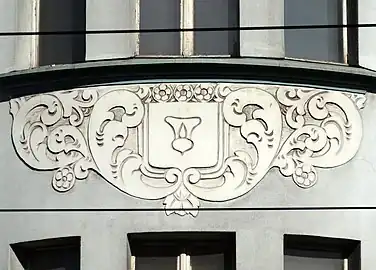 Art Nouveau detail
Art Nouveau detail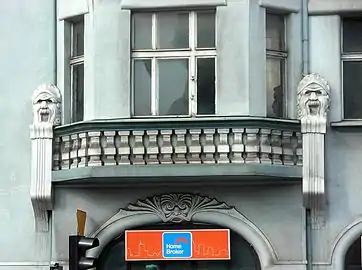 Masked faces on the facade
Masked faces on the facade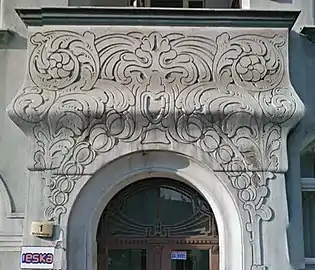 Detail of the portal
Detail of the portal Detail of the carved door
Detail of the carved door Detail of a bow window
Detail of a bow window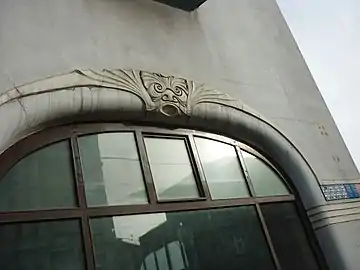 Detail of a motif
Detail of a motif
See also
References
- 1 2 zabytek|kujawsko-pomorskie|issued=1.03.2014
- ↑ "names". Adressbuch nebst allgemeinem Geschäfts-Anzeiger von Bromberg und dessen Vororten für 1900: auf Grund amtlicher und privater Unterlagen. Bromberg: Dittmann. 1900. p. 126.
- ↑ Jastrzębska-Puzowska, Iwona (2006). Od miasteczka do metropolii. Rozwój architektoniczny i urbanistyczny Bydgoszczy w latach 1850–1920. Bydgoszcz: Mado. ISBN 8389886715.
- ↑ Tota, Justina (23 February 2017). "W kamienicy na rogu Gdańskiej i Mickiewicza będzie hotel". expressbydgoski.pl. expressbydgoski. Retrieved 21 May 2018.
- 1 2 "Art Nouveau Design: Characteristics, History, Artists". visual-arts-cork.com. Retrieved 6 March 2015.
External links
Bibliography
- (in Polish) Bręczewska-Kulesza Daria, Derkowska-Kostkowska Bogna, Wysocka A. (2003). Ulica Gdańska. Przewodnik historyczny. Bydgoszcz: Wojewódzki Ośrodek Kultury w Bydgoszczy. ISBN 9788386970100.
